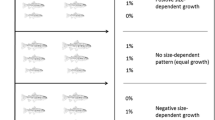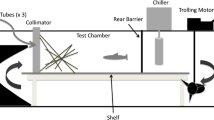Synopsis
Juvenile Atlantic salmon emigrate from the river in a given year as a consequence of a physiological decision influencing appetite and growth during the previous summer. The direction of the decision depends on developmental performance exceeding a genetically determined threshold at that time, and that performance is governed by environmental opportunity. The animal's foraging efficiency (ability to avoid predators, and to compete) determines how well that opportunity is used. Those fish which maintained relatively high growth after July preferred higher stream flows, and were more likely to hide than to flee from a predator. Predator vigilance reduced intake, and ability to discriminate edible particles. Early competitive ability depended on fierceness rather than size, and ultimate large size was a consequence of dominant status. Initial status among high ranking individuals (but not among low ones) predicted the likelihood of maintaining growth in late summer. Size by July was the better predictor for low ranked fish. The influence of high status on life-history variation depends on how much it suppresses the growth of those lower in the hierarchy.
Similar content being viewed by others
References cited
Abbott, J.C. R.L. Dunbrack & C.D. Orr. 1985. The interaction between size and experience in dominance relationships of juvenile steelhead trout (Salmo gairdneri). Behaviour 92: 241–253.
Bakker, T.C.M. 1986. Aggressiveness in sticklebacks (Gasterosteus aculeatus L.): a behaviour-genetic study. Behaviour 98: 1–144.
Donnelly, W.A. & L.M. Dill. 1984. Evidence for crypsis in coho salmon, Oncorhynchus kisutch (Walbaum), parr: substrate colour preference and achromatic reflectance. J. Fish Biol. 25: 183–195.
Fausch, K.D. 1984. Profitable stream positions for salmonids: relating specific growth rate to net energy gain. Can. J. Zool. 62: 441–451.
Frey, D.F. & R.J. Miller. 1972. The establishment of dominance relationships in the blue gourami, Trichogaster trichopterus (Pallas). Behaviour 42: 8–62.
Higgins, P.J. 1985. Metabolic differences between Atlantic salmon (Salmo salar) parr and smolts. Aquaculture 45: 33–53.
Higgins, P.J. & C. Talbot. 1985. Growth and feeding in juvenile Atlantic salmon. pp. 243–263. In: C.B. Cowey A.M. MacKie & J.G. Bell(ed.) Nutrition and Feeding in Fish, Academic Press, London.
Huntingford, F.A. N.B. Metcalfe & J.E. Thorpe. 1988a. Feeding motivation and response to predation risk in Atlantic salmon parr adopting different life history strategies. J. Fish Biol. 32: 777–782.
Huntingford, F.A. N.B. Metcalfe & J.E. Thorpe. 1988b. Choice of feeding station in Atlantic salmon, Salmo salar, parr: effects of predation risk, season and life history strategy. J. Fish Biol. 33: 917–924.
Huntingford, F.A. N.B. Metcalfe J.E. Thorpe W.D. Graham & C.E. Adams. 1990. Social dominance and body size in Atlantic salmon parr (Salmo salar L.). J. Fish Biol. 36: 877–881.
Kalleberg, H. 1958. Observations in a stream tank of territoriality and competition in juvenile salmon and trout. Rep. Inst. Freshw. Res. Drottingholm 39: 55–98.
Keenleyside, M.H.A. & F.T. Yamamoto. 1962. Territorial behaviour of juvenile Atlantic salmon (Salmo salar L.). Behaviour 19: 139–169.
Kristinsson, J.B. R.L. Saunders & A.J. Wiggs. 1985. Growth dynamics during the development of bimodal length-frequency distribution in juvenile Atlantic salmon (Salmo salar L.). Aquaculture 45: 1–20.
Metcalfe, N.B. 1986. Intraspecific variation in competitive ability and food intake in salmonids: consequences for energy budgets and growth rates. J. Fish Biol. 28: 525–531.
Metcalfe, N.B. F.A. Huntingford & J.E. Thorpe. 1986. Seasonal changes in feeding motivation of juvenile Atlantic salmon (Salmo salar). Can. J. Zool. 64: 2439–2446.
Metcalfe, N.B. F.A. Huntingford & J.E. Thorpe. 1987a. The influence of predation risk on the feeding motivation and foraging strategy of juvenile Atlantic salmon. Anim. Behav. 35: 901–911.
Metcalfe, N.B. F.A. Huntingford & J.E. Thorpe. 1987b. Predation risk impairs diet selection in juvenile salmon. Anim. Behav. 35: 931–933.
Metcalfe, N.B. F.A. Huntingford & J.E. Thorpe. 1988. Feeding intensity, growth rates, and the establishment of life-history patterns in juvenile Atlantic salmon Salmo salar. J. Anim. Ecol. 57: 463–474.
Metcalfe, N.B. F.A. Huntingford W.D. Graham & J.E. Thorpe. 1989. Early social status and the development of life-history strategies in Atlantic salmon. Proc. Roy. Soc. Lond. B 236: 7–19.
Metcalfe, N.B., F.A. Huntingford, J.E. Thorpe & C.E. Adams. 1991. The effects of social status on life history variation in juvenile salmon. Can. J. Zool. (in press).
Nicieza, A.G., F. Brana & M.M. Toledo. 1991. Development of length bimodality and smolting in wild stocks of Atlantic salmon, Salmo salar L., under different growth conditions. J. Fish Biol. (in press).
Stradmeyer, L. & J.E. Thorpe. 1987a. Feeding behaviour of wild Atlantic salmon, Salmo salar L., parr in mid- to late-summer in a Scottish river. Aquac. Fish Manag. 18: 33–49.
Stradmeyer, L. & J.E. Thorpe. 1987b. The responses of hatchery-reared Atlantic salmon, Salmo salar L., parr to pelletted and wild prey. Aquac. Fish Manag. 18: 51–61.
Stradmeyer, L., N.B. Metcalfe & J.E. Thorpe. 1988. Effect of food pellet shape and texture on the feeding response of juvenile Atlantic salmon. Aquaculture 73: 217–228.
Thorpe, J.E. 1977. Bimodal distribution of length of juvenile Atlantic salmon (Salmo salar L.) under artificial rearing conditions. J. Fish Biol. 11: 175–184.
Thorpe, J.E. 1986. Age at first maturity in Atlantic salmon, Salmo salar: freshwater period influences and conflicts with smolting. Can. Spec. Publ. Fish Aquat. Sci. 89: 7–14.
Thorpe, J.E. 1987. Environmental regulation of growth patterns in juvenile Atlantic salmon. pp. 463–474. In: R.C. Summerfelt & G.E. Hall(ed.) Age and Growth in Fishes, Iowa State University Press, Ames.
Thorpe, J.E. 1989. Developmental variation in salmonid populations. J. Fish Biol. 35 (Suppl. A): 295–303.
Thorpe, J.E., C.E. Adams, M.S. Miles & D.S. Keay. 1989. Some photoperiod and temperature influences on growth opportunity in juvenile Atlantic salmon, Salmo salar L. Aquaculture 82: 119–126.
Thorpe, J.E. & R.I.G. Morgan. 1978. Parental influence on growth rate, smolting rate and survival in hatchery reared juvenile Atlantic salmon, Salmo salar L. J. Fish Biol. 13: 549–556.
Thorpe, J.E. R.I.G. Morgan, E.M. Ottaway & M.S. Miles. 1980. Time of divergence of growth groups between potential 1 + and 2 + smolts among sibling Atlantic salmon. J. Fish Biol. 17: 13–21.
Thorpe, J.E. R.I.G. Morgan C. Talbot & M.S. Miles. 1983. Inheritance of developmental rates in Atlantic salmon. Aquaculture 33: 123–132.
Turner, G. & F.A. Huntingford. 1986. A problem for game theory analysis: assessment and intention in male mouth-brooder contests. Anim. Behav. 34: 961–970.
Villarreal, C.A. J.E. Thorpe & M.S. Miles. 1988. Influence of photoperiod on growth changes in juvenile Atlantic salmon, Salmo salar L. J. Fish Biol. 33: 15–30.
Wankowski, J.W.J. 1979. Morphological limitations, prey size selectivity, and growth response of juvenile Atlantic salmon, Salmo salar. J. Fish Biol. 14: 89–100.
Wankowski, J.W.J. 1981. Behavioural aspects of predation by juvenile Atlantic salmon (Salmo salar L.) on particulate drifting prey. Anim. Behav. 29: 557–571.
Wankowski, J.W.J. & J.E. Thorpe. 1979a. Spatial distribution and feeding in Atlantic salmon, Salmo salar L., juveniles. J. Fish Biol. 14: 239–247.
Wankowski, J.W.J. & J.E. Thorpe. 1979b. The role of food particle size in the growth of juvenile Atlantic salmon (Salmo salar L.). J. Fish Biol. 14: 351–370.
Wright, P.J., N.B. Metcalfe & J.E. Thorpe. 1990. Otolith and somatic growth rates in Atlantic salmon part, Salmo salar L.: evidence against coupling. J. Fish Biol. 36: 241–249.
Author information
Authors and Affiliations
Additional information
Invited review
Rights and permissions
About this article
Cite this article
Thorpe, J.E., Metcalfe, N.B. & Huntingford, F.A. Behavioural influences on life-history variation in juvenile Atlantic salmon, Salmo salar . Environ Biol Fish 33, 331–340 (1992). https://doi.org/10.1007/BF00010944
Received:
Accepted:
Issue Date:
DOI: https://doi.org/10.1007/BF00010944




